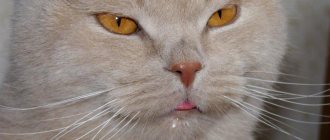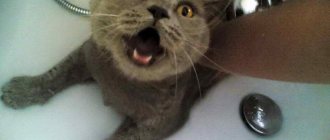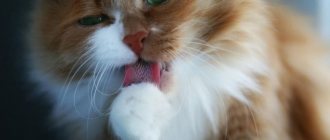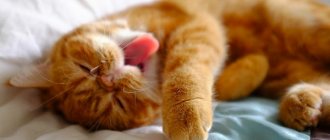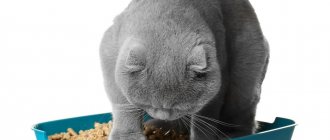If a cat's lower lip is swollen, this may indicate mechanical damage or be the first sign of the development of cancer. For this reason, it is worth contacting a veterinary clinic in order to notice the pathology in time. When a cat or adult has a swelling or bump in the lip area, redness, swelling and inflammation are additionally recorded. In the early stages, cat pathology is eliminated with medication, but if the case is advanced, including oncology, then surgical intervention is used.
What to do if your cat has a swollen lower lip
Even if the cause of swollen lips in a cat is obvious, it is still better to take the animal for examination to a veterinarian rather than self-medicate. The doctor will conduct an examination, tests (this will help rule out similar diseases) and prescribe the most appropriate treatment:
- Dental diseases are treated with anti-inflammatory drugs (for example, Prednisolone is used), and the gums are washed with antiseptic solutions. Plaque must be cleaned and tartar removed. If necessary, a tooth is removed in the area where inflammation occurred.
- If you have an allergy, the first thing to do is to interrupt contact with the allergen (stop giving the food to which the reaction occurred, wash off the applied product from the skin). Then the cat is given antihistamines:
- Suprastin;
Suprastin suppresses allergic reactions - Hydroxyzine;
- Chlorpheniramine.
Diphenhydramine;
When the cause is a fungal infection, they use drugs like Fungivet cream, Zoomikol, Imaverol. If an abscess has formed on the cat's lip, the doctor opens it and squeezes out the purulent contents. The procedure is performed under local anesthesia. After opening, a bandage is applied with a hypertonic solution and antibacterial ointments. Imaverol is prescribed in cases of fungal infections
To do this, the affected area is washed with clean water, treated with a weak solution of potassium permanganate, and an anti-burn or bactericidal ointment is applied (Levomekol, Sangel, Sanatol, Ranosan are suitable). Then you need to apply a bandage to the lower jaw. Bandages must be changed every day. Levomekol prevents infection of the burn surface
For rapidly growing tumors or if drug therapy is ineffective, surgery is prescribed. For any reason for swollen lips, it is recommended to use a veterinary collar during treatment, which will avoid scratching the affected area and will not allow the cat to remove the applied bandage.
If a cat has swelling of the lower lip, it is necessary to carefully examine the animal for wounds, burns and other distinctive signs. If the cause is not obvious, only a veterinarian can make a diagnosis. Once the source of the problem is identified, treatment must begin immediately. You can’t let things take their course, since many diseases accompanied by swollen lips progress quickly and pose a danger to the cat’s life.
Allergy
Another common cause of swelling is an allergic reaction. Swelling and redness of the mouth can be caused by:
- Reaction to insect bites.
- Food allergies.
- Contact dermatitis.
Most often, severe swelling develops from insect bites. The venom of wasps, bees and some types of spiders is a strong allergen, which, when it enters the body, triggers an immunopathological process. Symptoms of insect sting allergy:
- presence of signs of a bite;
- swelling of the skin around the bitten area;
- itching and burning;
- hyperemia and hyperthermia of the skin.
These are symptoms of a common allergic reaction that occurs without complications. In acute allergies, anaphylaxis or Quincke's edema may develop. This is dangerous due to the spread of swelling to the larynx and paralysis of the respiratory tract, which leads to death. Angioedema requires immediate medical attention.
An acute allergic reaction can be recognized by the rapid increase in symptoms. An allergy to insect bites always develops literally a few minutes after the poison enters the animal’s body.
If a cat's lower lip is swollen after changing its diet, it is a sign of food intolerance. This allergy develops slowly as the irritant accumulates in the body. This is manifested by swelling and redness of the rim of the mouth, itching, spots on the ears and around the nose.
Contact dermatitis is a type of allergic reaction that develops as a result of the action of an irritant on the skin. It occurs when household chemicals, medications, or cat cleaning products come into contact with the area around the mouth. The disorder is manifested by skin hyperemia, swelling, itching. The cat becomes restless and scratches the area around its mouth until it bleeds.
In case of allergic reactions, the first thing to do is to interrupt contact with the irritant. If you have food intolerance, you should change the food; if you have dermatitis, you should cleanse the skin of any remaining irritant. Then the animal is given antihistamines, ointments and gels for allergies can be used.
The cat's upper lip is swollen photo
Indeed, some remedies help both humans and animals such as cats equally well. But in some cases, veterinary drugs developed specifically for animals are required. In addition, it is necessary to make a correct diagnosis: the symptoms of many diseases are similar, and tests cannot be done without. So it is strictly not recommended to treat your pet yourself.
The following painful conditions can cause swelling on a cat's upper lip:
- Insect, snake bite. A cat that has free access to the outdoors enjoys practicing its hunting skills. Sometimes the animal lacks dexterity, and the potential victim manages to bite the hunter. The venom of an insect or snake not only causes severe swelling, but is also dangerous: you need to urgently show your pet to a veterinarian. Unfortunately, not many owners know what to do if a cat is bitten by a wasp or other stinging insect.
- Flea dermatitis. Exoparasites cause a lot of trouble for their owner. When a cat bites a flea, particles of excrement and saliva land on the lip and can cause severe irritation and swelling. However, the presence of fleas in a pet is completely insufficient for a final diagnosis.
- Fracture or bruise. These injuries are often accompanied by bruising or swelling. An active pet can hit itself at home if it does not calculate the trajectory of its flight from the windowsill to the closet. But fractures most often occur in free-ranging animals.
- Allergy. This is one of the most common reasons why a cat has a swollen upper lip. The matter is complicated by the difficulty of diagnosis: the provoking factor is not easy to identify, and besides, infection often penetrates into the affected area. A striking example is eosinophilic ulcer, which has long been considered a symptom of a variety of infections. It has now been precisely established that the cause of this phenomenon is allergy. “Wandering” swelling is another symptom of allergy. First, the animal’s ear may swell; after a few hours, the swelling creeps onto the cheek, then onto the lip, and so on. Eating store-bought food is a more common cause of allergies than is commonly thought. It is also believed that dry food crumbs can get stuck between the hairs around the mouth and cause irritation and swelling. If you are prone to food allergies, it is better to feed your pet natural food: chicken heads, necks, poultry, offal and lean beef - all raw. Another cause of swelling can be an allergy to toilet filler. Those at risk are desperate diggers and neat people who carefully mask the traces of their delicate affairs. All kinds of cat shampoos, as well as household chemicals, often provoke allergies. Substances contained in the leaves of many indoor plants cause an allergic reaction in cats. Allergy treatment is always long-term, complex and selected strictly individually.
- Oral diseases. Diseases of the gums and teeth are almost always accompanied by swelling of the tissues surrounding the source of inflammation. In some cases, the face swells so much that even the most “patient” owners begin to worry about the life of their pet.
- Viral infections. Viral infections can cause symptoms in the form of swelling.
- Burns. It is possible that the cat's upper lip is swollen due to a burn. The animal might become interested in the electric stove or heater that was just turned off. A cat can also get an electrical burn from chewing on wires. For the safety of your pet, it is advisable to limit access to the stove and hide the wiring.
- Fungal infections. Such diseases may also be accompanied by edema.
- Abscess. Or an abscess can develop anywhere, including on the upper lip. The abscess requires urgent surgical intervention, and after surgery the animal needs daily very painful procedures to clean the wound. The sooner your pet gets to the veterinarian, the easier the healing process will be.
- Neoplasms. At first, the tumor may be modest in size and not bother your pet in any way. If the neoplasm is benign and does not tend to grow, you can leave the swelling alone. However, it could be cancer: an accurate diagnosis can only be made in a veterinary clinic.
The pet’s face is always “in full view” from the owner, but the onset of the disease may not be noticed. As a preventive measure, it is advisable to regularly examine your pet’s oral cavity, not let him go outside, and use household chemicals less often.
Related publications:
What to do if your cat scratches its ears and shakes its head
Why does a cat shake his head?
What can cause a cat's tail to hang?
Rectal prolapse in cats: treatment, professional measures…
Diagnosis and identification of causes
In some cases, the owner can independently determine the reason that the lower lip is slightly enlarged and swollen. This is possible in cases where it is reliably known about an injury, an insect bite, or the presence of an allergic reaction.
In most cases, a simple visual inspection of a cat with a swollen lip will be sufficient. The doctor may also take a sample of biomaterials for analysis to determine the presence of a bacterial or fungal infection. You may also need a blood test to get a more complete picture of your cat's health.
If there is a suspicion of swelling due to a benign or malignant neoplasm, a biopsy, ultrasound and x-ray examination will be required. These measures are necessary to confirm or exclude the presence of tumors, determine their nature, as well as the stage of the disease.
Swollen lips in a cat can indicate a variety of processes in the animal's body. This alarming symptom should not be ignored. It is better to immediately rule out the presence of a serious pathology than to try to cope with a serious illness later. Owners should not be faced with the question of whether to see a doctor or not.
The choice of treatment method depends directly on why the lip is swollen. You should not prescribe treatment for an animal yourself, since the wrong choice of method and means may not only not improve the pet’s condition, but also significantly worsen it.
If you were able to independently (and accurately) determine the cause of the swelling on the lip, you should not personally prescribe treatment for your pet. Consultation with a salesperson at a veterinary pharmacy may also not be sufficiently informative and useful. Only an experienced and qualified specialist should select the optimal method of treating a cat with a swollen lip. When prescribing treatment, the history of previous diseases and treatments, characteristics of the breed, sex and age of the animal, etc. should be taken into account.
What to do and how to treat a cat’s lower lip depends on the reasons why it is swollen:
- Injuries. Treatment is symptomatic. The choice of specific method depends on the extent of the injury. For a slight bruise, it will be enough to treat the skin with an antiseptic. In more severe cases, you should consult a doctor, as stitches may be required at the wound site.
- Swelling due to dry food. No treatment required. To get rid of swelling, it is enough to start giving your cat dry food with a softer consistency or completely abandon it.
- Bite of another animal. The injury site must be treated with an antiseptic. If a cat is bitten by someone else's animal, or an animal that lives on the street, it is advisable to seek medical help and get vaccinated against rabies. Stitches may be required.
- Insect bite. You need to treat the bite site with an antiseptic and try to remove the sting. Then apply a cold compress and hold for several minutes. If your cat has a fever and weakness, you should take your pet to a veterinary clinic.
- Allergy. If you have an allergic reaction, only a doctor can prescribe an antihistamine. It will also help determine the required dose. Even if a cat is prescribed a “human” drug, its dose will be 2, 3 or 4 times less for humans. If an allergy due to parasites is suspected, the cat should be tested for helminths, ear mites, and examined for fleas and ticks.
- Viral infection. At the first suspicion of a viral infection, an animal with a swollen lip should be shown to a veterinarian. The cat will be prescribed antibiotics.
- Tumor or cyst of the salivary glands. The cyst is eliminated by puncture and subsequent removal of its contents. In some cases, when the puncture does not bring the desired result, it may be necessary to remove the salivary gland.
- Malignant tumor. Treatment is only surgical. In severe cases, it may be necessary to remove surrounding tissue or the entire lower jaw.
- Acne. Only a veterinarian can prescribe treatment. First of all, it should be aimed at slowing the progression of the disease. Acne is then treated in a similar way as in humans.
You should not delay going to the doctor and starting treatment. Timely assistance to your pet is a guarantee of its health and long life.
Bruises
Another reason why a cat’s upper or lower lip is swollen can be a hematoma. Usually such a problem is preceded by a fall or a slight blow. Treatment consists of applying cold to the bruise. But first you need to make sure that the animal does not have any dislocations or damage to the jaw. Most often, active cats suffer from such bruises. Therefore, owners of animals prone to bruises are advised to learn how to provide first aid and have antiseptic solutions in their veterinary first aid kit.
If a cat spends a lot of time outside, an insect bite can cause swelling. The lip swells very sharply and begins to itch (at the same time the animal may meow for a long time). As first aid, it is recommended to give your pet Suprastin, Loratadine. If home treatment is successful, the swelling will subside within a few hours.
Attention! Bee and wasp stings are deadly for cats with allergies. You should not try to pull out the sting; it is better to immediately take your pet to a veterinary clinic
The cat's lower lip is swollen: associated symptoms
Regardless of the cause of inflammation, swelling develops around the lip. The skin begins to peel, turns red, and ulcerations appear.
The cat has difficulty eating, as well as the following accompanying symptoms:
- loss of appetite or refusal to eat due to pain while eating.
- profuse drooling;
- resistance when the owner tries to examine the mouth and aggressive rumbling;
- bad breath;
- swelling of the muzzle due to inflamed salivary glands;
- the tongue is hyperemic or has a dirty gray coating on it;
- the animal is losing weight;
- the coat loses its shine and becomes disheveled.
Associated symptoms
If a cat's lower lip is swollen, then this in itself is a symptom of various kinds of pathological processes in the body. However, in most cases, if the lip is swollen, it happens for completely harmless reasons. You should be wary only if there are accompanying negative signs.
Alarming symptoms:
- hard swelling structure;
- increased body temperature;
- lack of appetite;
- discharge of pus;
- blisters on the mucous membrane;
- the lip turned red;
- significant swelling;
- bad breath;
- spread of the tumor to surrounding tissues;
- discharge from the eyes and nose.
© shutterstock
Causes of chin swelling
All pet owners worry about the health of their pets and try in every possible way to protect the animal from health threats. This condition can be caused by various diseases and infections. Let's look at some of them.
Cat acne
This disease is manifested by the presence of blackheads, inflammation and swelling around them, due to clogged pores. Low-quality food and insufficiently clean dishes are also considered factors in the formation of acne. For example, a polymer bowl absorbs various bacteria that cannot be washed off with ordinary water. In such an environment, bacteria quickly begin to develop. A pet touches a dangerous area, resulting in acne. If measures are not taken in time, the disease will develop into a purulent pathology.
Bites from insects and other animals
A cat's chin can become swollen as a result of an attack by bees, wasps or snakes. In such a situation, the owner should be promptly given an antihistamine. And in the case of a snake bite, treat the wound so that it does not become infected.
If the snake is poisonous, then quickly take your pet to the veterinarian, since poison entering the wound can cause shock, collapse and even death.
Dentistry and abscess
The cause of a dental abscess is considered to be dental problems that affect cats over 3 years of age. This is a fairly common phenomenon that can be overcome with constant oral hygiene. The cat's jaw is inflamed due to a broken tooth. If such a disease occurs, you should contact a veterinarian.
Allergy
A cat's chin swells due to attacks from fleas, ticks, eating bad foods and other allergens. The allergy is expressed by the appearance of swelling in the neck and lips.
Neoplasms
This problem is most often observed in adult cats over 12 years of age. In young people, neoplasms are extremely rare.
The causes of cat tumors include canned food and the owner’s tendency to smoke. Cats who eat such food in large quantities have a high risk of developing thyroid adenoma and squamous cell carcinoma. It is also worth noting that urine analysis of pets whose owners are considered to be smokers revealed a high content of the nicotine metabolite.
Possible reasons
Often, even attentive owners do not immediately notice a swelling on the lip. Having discovered it, the question arises as to what is the reason why the cat’s lower lip is swollen.
© shutterstock
The most common reasons why cats may have a swollen lower lip:
- Introduction of dry food into the diet . Cats may develop a callus on their lower lip due to the unusual consistency of the food. Hard granules rub the lip, and this leads to swelling.
- Trauma . A cat can injure its lower lip during active play. This can happen either during a fall from a height, or when colliding with objects, or when trying to chew on a hard toy.
- Bite of another animal . This happens quite often if the cat is outdoors, where it comes into contact with other animals. This can also happen if, in addition to the cat, other pets live in the house. Animal games can be quite active and aggressive.
- Insect bite . A cat can be bitten by various insects - bees, wasps, horseflies.
- Allergic reaction . A cat can be allergic to different things. It can occur due to contact with household chemicals, flowers, plants, new food and various other irritants. Various parasites can also be the cause: helminths, fleas and ticks.
- Viral infection . It is expressed in the presence of small blisters on the oral mucosa that may resemble herpes.
- Tumor or cyst of the salivary glands . Occurs due to injury to the salivary glands. This may occur due to injury to the lower lip.
- Malignant tumor . Cancer can affect any tissue in the mouth. It can also affect the lower lip. The swollen lip will feel hard to the touch.
- Acne . You may notice black dots on a swollen lip. They are often accompanied by the presence of small pimples. When the disease is advanced, crusts, inflammation, ulcers, nodules, and extensive redness can be observed on the lower lip and chin. When touched, pain may occur.
When is it necessary to consult a veterinarian?
Why might this problem require veterinary help? Firstly, it is not always possible to identify the cause of swelling and redness on a pet’s lip at home; secondly, even if the factor that provoked such a phenomenon is obvious, a veterinarian should prescribe treatment, since improper therapy can lead to severe, and sometimes even irreversible consequences.
Contacting a veterinary clinic is required in the following cases:
- lethargy, apathy, lack of response to external stimuli, decreased motor activity;
- partial or complete loss of interest in food;
- increased body temperature;
- deterioration of the respiratory organs (shortness of breath, wheezing, lack of oxygen);
- indigestion (vomiting, diarrhea or constipation);
- tumor enlargement;
- symptoms of an allergic reaction that cannot be eliminated with an antihistamine;
- discharge from the nasal passages and eyes;
- significant violation of the integrity of the skin when the lip is injured.
Treatment of the disease
If a cat has a swollen lower lip, the therapeutic effect depends entirely on the cause that caused this phenomenon. Below we consider methods of treating this problem depending on its pathogenesis:
- If this happened because the cat was switched to dry food, then simply change her diet and the problem will disappear in 5-6 days by itself.
- For injuries and burns, smear the affected area with such effective remedies as Levomekol, Sangel, Sanatol, Ranosan. They can be used both in the form of powders or gels, and in the form of ointments or sprays.
- If the owner suspects that the reason is an allergic reaction to something, then it is permissible to give him Suprastin.
- Oncological neoplasms are treated as follows: malignant - with chemotherapy and strong painkillers, benign - with surgical intervention.
- The fungus can be eliminated by such products as Fungivet-cream, Zoomikol, Imaverol.
- Inflammation with viral etiology is affected by Camedon, Anandin, Kanamycin.
- Lincomycin, Sinulox, and Levamisole have performed well in the fight against infections.
Each of the above drugs can only be prescribed by a doctor, based on the general condition of the cat, its age and weight. Do not self-medicate under any circumstances, this will only aggravate the problem and cause more suffering to your mustachioed friend.
Finally, I would like to say that neither a kitten nor an adult cat is immune from the occurrence of such a phenomenon. There are many reasons for this
Therefore, it is important to take your pet for examination to a doctor and, based on the recommendations received, carry out therapeutic therapy. Otherwise, the pet may die
The anomaly appears in the following situations:
- allergic reaction;
- change of feed;
- injury;
- tumor;
- acne.
Allergic reaction
With a hypersensitive response, in addition to swelling of the lip, other symptoms appear, for example, conjunctivitis or nasal discharge, skin rash. Interrupting contact with the allergen and using an antihistamine eliminates the problem.
Change of feed
Thin lips are observed when switching from wet to dry food. But most often the problem arises when an animal accustomed to natural nutrition is treated with dense granules. It is necessary to gradually transfer the pet to dry feeding or abandon it.
Injury
Damage occurs as a result of a bruise, a bite, or if the cat is stung by an insect. For minor injuries, they limit themselves to treating the affected area with an antimicrobial agent. What to do when the swelling does not go away for a long time? Contact the clinic. Otherwise, inflammation of the salivary gland will develop. It becomes clogged and a cyst forms. Treatment is surgical. The pathological cavity is pierced or removed.
The viral disease mainly affects unvaccinated young animals. In addition to a swollen lip, the disease manifests itself with other signs. Characteristic symptoms are tongue ulcers. Detected symptoms are the basis for contacting the clinic.
Tumor
In old animals, the appearance of a tumor on the lower lip raises suspicion of the formation of a neoplasm. The defect discovered in the early phase of the pathology is excised, and the animal recovers. If the cat owner ignores the tumor that has arisen, it will transform into malignant.
Acne
In this case, the swelling is combined with the presence of black spots on the chin. The disease occurs due to improper maintenance. Using a plastic feeder and treating your pet to fatty table scraps lead to the deposition of dirt on the cat’s chin. The second infection multiplies, inflammation begins, and black comedones form. Treatment is carried out with external antiseptics.
Diseases in animals occur as often as in humans. We take care of the health of our pets ourselves. The cat's body is weaker than that of dogs, so cats need more responsible treatment.
If a cat's lower lip is swollen, it could be either a slight bruise or cancer. It is necessary to check the animal’s lymph nodes to see if they have enlarged. If you are not an experienced veterinarian, then it is impossible to find out the reason why your pet’s sponge is swollen. Only a veterinarian can help determine the cause of the disease. The reasons why edema and swelling occurs on a cat’s lip are very different.
More about eosinophilic granuloma
Feline eosinophilic granuloma can occur not only due to decreased immunity, but also due to allergies and bacteria. I started analyzing. As I already said, our immunity was clearly all right. Allergies and bacteria remained. And then I remembered what preceded the appearance of Angelina Jolie’s lips on my cat.
Firstly, she found her way to a ficus tree on the closet and started gnawing on it. And ficus is known to be toxic to cats and can cause allergies and stomatitis. If you've ever trimmed the leaves of a ficus tree, you know that it produces a pungent white sap. Secondly, a couple of weeks before the problem arose, I bought a large plastic water dish for the cat, because... I read that cats love large transparent containers and drink more actively from there. Plastic is sometimes toxic, and it also has large pores where food and water residues get clogged and where bacteria subsequently develop, terrorizing the mouth of a cat drinking from plastic. Thirdly, even to normal plastic there is an individual allergic reaction.
I did not check all the versions one by one to understand which one was correct. I immediately excluded both ficus and plastic dishes from the cat’s life. After just 4 days, there was no trace left of the swollen lips. As I realized later, the problem most likely was a reaction to bacteria in the pores of the plastic, because... She got to the ficus several times after that, but there was no more reaction, plus at that moment my cat also developed acne. I didn’t notice it right away, and the vet didn’t see it at all (or didn’t pay attention to it).
Externally, acne resembles dirt crushed onto the chin. By the way, at first I thought that the cat was rummaging in the flower pot. But then, while studying veterinary articles, I realized that it was acne. So, after eliminating the plastic container, the acne went away along with the granuloma. Coincidence? Don't think.
ACNE IN CATS is a skin disease in which the sebaceous glands become inflamed and clogged. Acne occurs as a result of stress, poor hygiene, abnormal development of the sebaceous glands, decreased immunity and (attention!) the use of plastic bowls when feeding. Sometimes acne is accompanied by a secondary infection. As a result, the area of skin with acne may become bald, itching, ulcers and swelling may appear on it.
In our case, it was enough to remove the plastic bowl, because... no secondary infection joined the process and there were no ulcers or pus. If an infection were to occur, antibiotics and treatment of the affected area with an antiseptic (chlorhexidine is often used) would be needed. And in cases where acne appears as a reaction to an allergen and it is not possible to calculate it yourself, it is necessary to carry out allergy tests or exclude one factor after another with an interval of about 1 week and wait to see which one works.
Granuloma and acne have other causes. Often these are hormonal surges that cats experience during estrus, pregnancy and childbirth, and male cats - during the rut. In this case, if the animal is not planned to be used for further breeding of kittens, castration helps.
The takeaway from this situation is that many veterinarians follow a simplified protocol that does not always involve calculating the cause of the syndrome. It's much easier to give an injection. Moreover, in our case, the doctor did not notice the acne, which means he simply did not conduct a quality examination. If you encounter the same veterinarian, you need to use your own logic. Think about what could have been the trigger (all factors in the last 2-3 weeks). Try eliminating different factors and check the result. In the end, only you are responsible for your pet's health.
However, I do not encourage you to make a diagnosis yourself, but I advise everyone who is faced with the problem of a swollen lip in a cat to immediately go to a good veterinary clinic, and here’s why. The fact is that a swollen lip in a cat can be a symptom not only of eosinophilic granuloma, but also of the following diseases.
Acne
If the swelling has small black dots, then you have acne. Normally, this appears once and then goes away without affecting the pet’s condition in any way. But if acne appears chronically, then this is a good reason to start treating it. In this case, in addition to the lower lip, the chin area is also affected. This disease can occur in animals of all ages. They develop pimples, crust-like formations on their lips, and sometimes swelling or inflammation.
If you do not treat your cat, there is a high chance that the acne will develop into an abscess and begin to cause pain to the animal. For assistance, please contact your veterinarian. First, drugs are prescribed that will slow down the infection process, and then drugs for local external use. Treatment in this case is usually determined by a three-week course. The exception is cases when the animal’s condition is completely advanced, then it will require constant treatment and constant monitoring of its health.
If it is not possible to contact a veterinarian, you can treat cat acne at home. To do this, you should create sterile conditions at the site of the lesion: maintain hygiene using shampoos with tar, treat pimples with peroxide and salicylic acid. After disinfection procedures, the affected area must be moistened using conventional antibacterial creams (for example, Sanoderm or Esprit).
Less obvious causes of lip swelling in a cat can be a number of other diseases, for example, acute renal failure or diabetes mellitus.
Main advice: if you find a swelling on your pet’s lower lip, it is best to seek help from a veterinary clinic as soon as possible, especially if the animal is experiencing discomfort and is clearly restless.
Neoplasms
The first thing that needs to be ruled out when a cat’s lower lip is swollen is the malignant nature of the neoplasm. The tumor can be caused by oral cancer. This pathology is very dangerous and often claims the lives of pets.
The tumor may be benign in nature, for example due to blockage of the salivary glands or accumulation of sebum. Only a veterinarian can make an accurate diagnosis. Regardless of the nature of development, tumors are treated surgically.
Causes of the disease
Experts can give a dozen different reasons why a cat’s lower lip could be swollen. Some of them are completely harmless and go away on their own, others can be treated at home, and there are others that can lead to a fatal outcome for a member of the feline family. Below we will discuss the most common factors that can cause a pet's lower lip to swell:
Burn wounds. There are thermal, electrical and chemical burns. The first option is rare, since cats rarely eat food that is too hot for them. However, your pet is capable of licking a hot frying pan if it smells delicious. Electrical burns occur because the animal likes to chew on live wires. Chemical lesions leading to swelling of the lower lip can be caused by household chemicals or animal hygiene products. A common symptom for each of them is severe inflammation located in the lip area. Insect bites. The lip may become swollen if it is stung by a wasp or bee. The owner is able to detect, in this case, the remaining sting. Over time, severe swelling occurs at the site of the lesion. Lip injuries. Occurs if the cat has a metal food bowl with sharp, uneven edges. In parallel with this, gum damage can also be detected. An animal can also get injuries to the soft tissues of its lower lip during a fight with its fellow tribesmen on the street. Oncology localized on the upper or lower lip. Rarely encountered, but extremely dangerous. In veterinary medicine, neoplasms of this kind are called squamous cell carcinoma. According to statistics, they are more often malignant, which means they are capable of metastasizing. Additional signs characterizing this disease include a putrid odor from the cat’s mouth, ulcers on the oral mucosa, and excessive salivation. Over time, the lymph node closest to the tumor becomes inflamed. A benign tumor can be removed surgically, but a malignant one, unfortunately, leads to death in 90% of cases. Allergic reaction. If the lip is inflamed for this reason, then the first thing the owner needs to do is to detect a harmful allergen that negatively affects the pet’s body. This could be plant pollen, components of a pet’s diet, household chemicals, bites of blood-sucking parasites, pharmaceuticals. If the irritant cannot be identified on your own, you should seek help from a qualified specialist. Industrial feed. If the lip is swollen after the cat was switched to dry food, then rest assured that this is the reason. This is especially true in cases where the animal previously ate natural food. The hardness of industrial feed provokes the appearance of calluses on the delicate tissue of the lip, where inflammation occurs. Gingivitis can be another of the many factors that cause a cat to have a swollen lower lip. Its striking symptoms are the cat’s bad breath, bleeding gums, and an orange border appears around the pet’s teeth. If the owner does not react promptly, the cat is in danger of losing a tooth completely. In addition, gingivitis “walks” hand in hand with such terrible diseases as diabetes and liver failure. Stomatitis in a cat, caused by the harmful activity of a fungus that has entered the oral cavity, can be determined by the fact that the upper lip is swollen. In this case, an additional sign is the formation of white plaque on the mucous membranes of the animal. This pathology can be caused by a decrease in the cat’s immunity or long-term treatment with certain pharmaceuticals. Calcivirosis in cats also leads to swelling of the lips and mucous membranes of the mouth. The disease has an infectious etiology, additional symptoms include lameness, mouth ulcers, conjunctivitis and loss of appetite. Requires surgical and complex therapy. Acne, another name is subcutaneous pimple. It occurs due to disruptions in the hormonal system, insufficient oral hygiene of the pet, and excessive activity of the sebaceous glands. Located in the corner of the lips, it does not cause much concern to the cat. You can remove a pimple yourself; to do this, wipe the affected area with antibacterial soap, and then apply an ointment that contains benzoyl peroxide.
It is important that the cat does not lick the medicine, and that it stays on the pimple for at least 5-6 minutes. Then wash off the remaining ointment with Chlorhexidine solution.
How to diagnose the cause
Treatment will depend on why the swelling occurs. Sometimes the source of the problem can be recognized immediately - for example, if a swollen lip occurs after a wasp or a bee has landed on it, then, without a doubt, the problem is an insect bite. But more often than not, the cause cannot be determined. To find out the diagnosis, you will have to carry out a number of manipulations. First of all, you need to observe the cat to identify other symptoms:
- Dental diseases, in addition to swelling of the lips, are accompanied by: an unpleasant odor from the cat’s mouth;
- redness of the gums;
- increased salivation.
- sudden weight loss;
Visual observation of the animal alone is not enough to establish the exact cause of lip swelling. Veterinarians also use a comprehensive diagnostic method, including:
- general blood analysis;
- tissue biopsy (to exclude tumor neoplasms);
- allergy test;
- microscopy (to detect bacterial infection, skin parasites, mycosis).
If dislocations or jaw fractures are suspected, radiography is performed.
How to cure a pet?
Of course, treatment does not need to begin until a final diagnosis is made. Each of the described conditions requires an individual treatment regimen. The drug Dexamethasone is often used to treat conditions that cause swollen lips and lesions in the mouth. Dexamethasone has the active ingredient dexamethasone disodium and is available in the form of injection ampoules. Dexamethasone has anti-inflammatory, anti-allergic and anti-shock effects.
In case of infectious lesions, Dexamethasone complements antibiotics. Dexamethasone should be given in the dosages specified in the instructions for use. Another drug that has a detrimental effect on a number of pathogenic microorganisms is Sinulox. Sinulox is available in the form of a suspension or tablets. Sinulox is effective for infectious lesions of soft tissues and mucous membranes. Sinulox is often prescribed for gingivitis. Sinulox should be given strictly according to the instructions for use. There is a tablet form of Sinulox.
>Photo gallery The request returned an empty result.
Viral infections
Infection with herpes - this virus also affects cats - is a likely cause if a cat has an ulcer on his lip. This is a sign of a very dangerous disease - rhinotracheitis. It should be noted that this is far from the only symptom, and a good owner will quickly come to his senses and take the cat to the veterinarian.
Diagnosis of the disease is almost always difficult. Tests often give conflicting results, and symptoms are similar to some other diseases. Only an experienced veterinarian can diagnose rhinotracheitis. Animals that do not receive qualified care often die. It is impossible to cure it - after therapy, the virus only ceases to manifest itself. Fortunately, an effective vaccine against rhinotracheitis has long been created.
Feline herpes is not dangerous to humans, but quickly infects other cats: if there are several of them in the house, the sick animal must be immediately isolated.
Helping a sick person
The sooner treatment is started, the greater the pet's chances of survival. Oncology can be benign; you just need to monitor its condition. Neoplasms often degenerate into malignant tumors, and then radical treatment methods are required. Trauma may indicate internal damage. Unhealed cracks and broken bones can cause serious complications. The cat needs an x-ray, which can be done in the clinic.
Infectious diseases require immediate treatment. After all, bacteria can spread to other parts of the body. A cat can infect other pets or its owner. It is not wise to prescribe medicinal formulations on your own, because first you need to identify the type of pathogen. And laboratory tests are carried out only in specialized clinics.
After an insect bite, a sting may remain inside the cat's lip. It needs to be pulled out, and doing this at home is very difficult. The breeder is advised to urgently take the animal to the veterinarian.
How to determine the disease?
More often the upper lip is affected on the right or left, less often on both sides at once. The ulcer has a clearly defined outline, its color is closer to brown, its size is 0.2-5 cm. There is no itching or pain, the pet clearly feels discomfort only at the time of eating or drinking. Therefore, the owner may notice that the pet has begun to avoid bowls. Additionally, the following can be found on the surface:
- plaques;
- miliary dermatitis;
- granulomas.
The same patient may experience different manifestations simultaneously. The localization of various manifestations of the disease can be: the abdomen or thigh, back or neck, lower lip or gums.
To exclude further manifestations of allergic dermatitis, it is recommended to conduct a special test. It will allow you to identify the problem to which the body develops a negative reaction. Often, tailed pets are allergic to dust, tobacco smoke, pollen, and mold.
